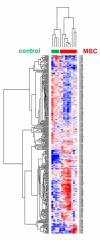Identification of differentially expressed microRNAs in human male breast cancer
- PMID: 20331864
- PMCID: PMC2850898
- DOI: 10.1186/1471-2407-10-109
Identification of differentially expressed microRNAs in human male breast cancer
Abstract
Background: The discovery of small non-coding RNAs and the subsequent analysis of microRNA expression patterns in human cancer specimens have provided completely new insights into cancer biology. Genetic and epigenetic data indicate oncogenic or tumor suppressor function of these pleiotropic regulators. Therefore, many studies analyzed the expression and function of microRNA in human breast cancer, the most frequent malignancy in females. However, nothing is known so far about microRNA expression in male breast cancer, accounting for approximately 1% of all breast cancer cases.
Methods: The expression of 319 microRNAs was analyzed in 9 primary human male breast tumors and in epithelial cells from 15 male gynecomastia specimens using fluorescence-labeled bead technology. For identification of differentially expressed microRNAs data were analyzed by cluster analysis and selected statistical methods.Expression levels were validated for the most up- or down-regulated microRNAs in this training cohort using real-time PCR methodology as well as in an independent test cohort comprising 12 cases of human male breast cancer.
Results: Unsupervised cluster analysis separated very well male breast cancer samples and control specimens according to their microRNA expression pattern indicating cancer-specific alterations of microRNA expression in human male breast cancer. miR-21, miR519d, miR-183, miR-197, and miR-493-5p were identified as most prominently up-regulated, miR-145 and miR-497 as most prominently down-regulated in male breast cancer.
Conclusions: Male breast cancer displays several differentially expressed microRNAs. Not all of them are shared with breast cancer biopsies from female patients indicating male breast cancer specific alterations of microRNA expression.
Figures




References
MeSH terms
Substances
LinkOut - more resources
Full Text Sources
Other Literature Sources
Medical

